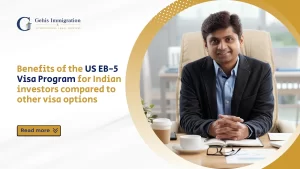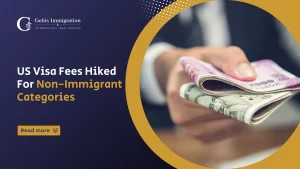New Requirements for H-1B Visa Application Where H-1B visa is a non-immigrant visa that temporarily allows U.S. employers to employ foreign workers in speciality occupations. These occupations often require specialised knowledge and a higher level of education, making the H-1B visa an essential avenue for companies seeking to fill skill gaps with international talent.
The H-1B visa allows skilled foreign workers to contribute expertise in the US, benefiting employers with diverse skills and perspectives.
Since immigration regulations always change, staying current on visa application criteria is critical. In this post, we will look at the upcoming changes to the H-1B visa program 2025, giving thorough guidance for future H-1B visa applicants and US companies.
Historical Context of H-1B Visa
Here’s a brief overview of the history and evolution of the H-1B visa program:
- Inception (1952): Before the H-1B visa, there was the H-1 visa from the 1952 Immigration and Nationality Act. It aimed to bring in foreign workers with exceptional skills in science, education, and business.
- Creation of H-1B Visa (1990): In 1990, the Immigration Act created the H-1B visa for skilled workers needed in the US. It enabled US employers to hire foreign professionals for specialty jobs for up to six years.
- Cap and Expansion (1990s-2000s): Initially, there was no limit on H-1B visas. As the program grew, worries about its effect on local workers emerged. In 1998, the ACWIA set a cap of 65,000 visas yearly, later raised to 195,000 by 2001.
- Dot-com Boom and Reforms (2000s): The late 1990s and early 2000s saw a surge in demand for skilled workers, particularly in the technology sector. However, concerns about abuse and fraud led to regulatory changes. The H-1B visa program underwent reforms, including establishing additional requirements for employers and increased enforcement efforts.
- Post-Dot-com Era (2000s-2010s): After the dot-com bubble burst, H-1B visa demand changed. Caps were adjusted, new rules were added to safeguard US workers, and promote fair labor practices. The H-1B program remained vital for bringing STEM talent.
- Executive Actions and Policy Changes (2017-2020): During the Trump administration, significant changes were made to the H-1B visa program. Executive orders and policy memos aimed to prioritize higher-skilled workers and address perceived system abuses, including the “Buy American, Hire American” initiative.
- Ongoing Evolution (2020’s): As of January 2022, the H-1B visa program was still changing. The Biden administration aimed to review immigration policies, with expectations of reforms to meet workforce needs, improve program integrity, and simplify procedures.
Understanding the history of the H-1B visa program reveals the challenges, changes, and policy decisions that have influenced its development.
Current Landscape of H-1B Visa
The H-1B visa is designed for foreign workers in speciality occupations that require specialised knowledge and a minimum educational qualification. Some eligibility criteria include:
- The foreign worker must have a job offer from a U.S. employer for a speciality occupation.
- The occupation must typically require a bachelor’s degree or equivalent in a specific field.
- The foreign worker must possess the required degree or its equivalent in education and experience.
- The employer must file an H-1B petition on behalf of the employee, and the petition must be approved by the U.S. Citizenship and Immigration Services (USCIS).
- H-1B visa statistics can provide insights into the demand for skilled foreign workers and the challenges applicants may face. Data includes the number of H-1B visa petitions filed, approved, and denied. Approval rates can vary, and factors such as changes in government policies and economic conditions can influence these statistics.
In recent years, there has been increased scrutiny of H-1B visa applications, leading to higher Requests for Evidence (RFEs) rates and, in some cases, denials. The data can also shed light on the industries and occupations that predominantly utilise the H-1B program.
The H-1B visa program has faced various challenges and criticisms, including:
Visa Cap: The annual cap on H-1B visas has been a persistent challenge. The demand often exceeds the supply, leading to a lottery system for selecting petitions. This can create uncertainty for both employers and prospective employees.
Fraud and Abuse Concerns: There have been concerns about potential fraud and abuse within the program. Some critics argue that the system is susceptible to exploitation, with employers allegedly using the H-1B program to hire foreign workers at lower wages, displacing U.S. workers.
Policy Changes and Uncertainty: The H-1B visa program has been subject to policy changes, creating uncertainty for employers and foreign workers. Changes in administration can bring shifts in priorities and regulations, impacting the program’s stability.
Processing Delays and Backlogs: Lengthy processing times and backlogs in visa processing have been a point of contention. Delays can affect the ability of employers to fill critical positions with skilled professionals timely.
It’s essential to stay updated on the latest developments and policy changes, as the H-1B visa program remains dynamic, and adjustments may occur to address challenges and criticisms. For the most up-to-date information, consult official government sources or immigration law specialists for accurate details.
Emerging Trends in U.S. Immigration Policy
Here are some notable recent changes in U.S. Immigration policies:
- Biden administration modified H-1B lottery, favoring applicants with US advanced degrees and STEM experience for selection.
- New temporary programs enable eligible individuals from Cuba, Haiti, Nicaragua, and Venezuela to enter the US for work authorization.
- DACA program, safeguarding Dreamers from deportation, faces legal uncertainty despite ongoing legislative attempts to ensure its continuation.
Shifts in Political and Economic Factors Influencing Immigration:
- Labour Shortages: Growing labour shortages in key sectors like healthcare and technology are pushing for more flexible immigration policies to attract skilled workers.
- Anti-immigrant Sentiment: While public opinion on immigration remains divided, anti-immigrant sentiment persists in some population segments, influencing political discourse and policymaking.
- Geopolitical Events: Global events like the war in Ukraine and the refugee crisis in Central America are placing renewed pressure on the U.S. to provide humanitarian assistance and offer safe havens.
Implications for H-1B Visa Applicants and Employers:
- The revised H-1B lottery system may make securing visas challenging for some applicants.
- Increased scrutiny of H-1B programs may lead to stricter wage and labour standards for employers.
- Potential reforms to H-1B and other employment-based visa programs could offer new opportunities for skilled immigrants and U.S. companies.
Final Word
The H-1B visa program has a rich history, starting in 1952 and growing into a crucial way for skilled foreign workers to join the US workforce. Over time, the program adapted to US economic needs and labor practice concerns through multiple adjustments and revisions.
The future outlook for the H-1B visa program is inherently tied to broader immigration policies, economic conditions, and geopolitical considerations. As ongoing societal, political, and economic shifts occur, they will influence the program’s trajectory despite its historical role in fostering innovation and addressing skill shortages.
To anticipate the program’s direction, stakeholders should monitor government initiatives, policy changes, and industry trends. Partnerships among policymakers, businesses, and academia can enhance the H-1B visa program to meet evolving global workforce demands.




